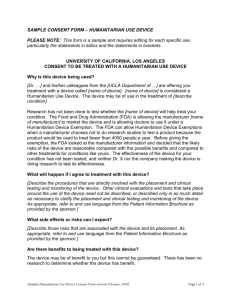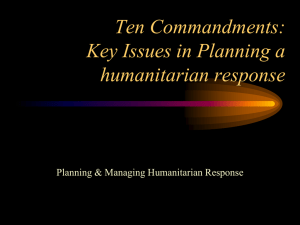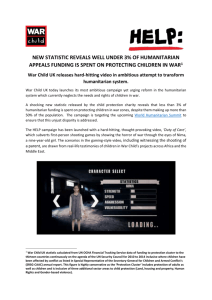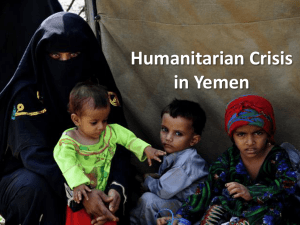- SocialProtection.org
advertisement
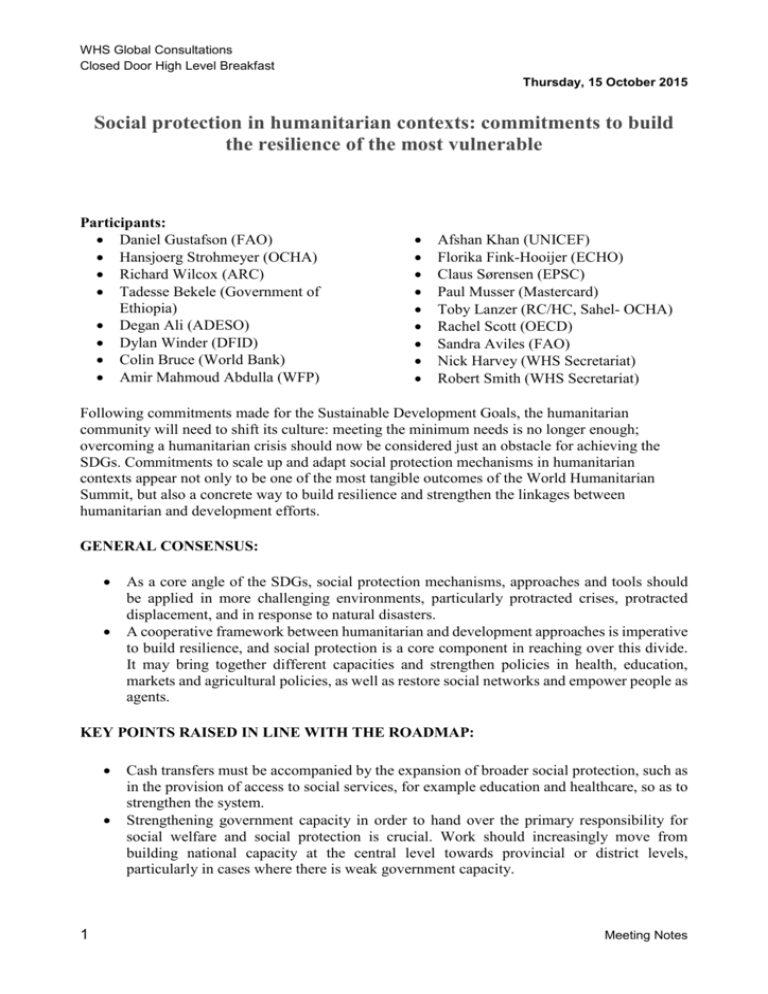
WHS Global Consultations Closed Door High Level Breakfast Thursday, 15 October 2015 Social protection in humanitarian contexts: commitments to build the resilience of the most vulnerable Participants: Daniel Gustafson (FAO) Hansjoerg Strohmeyer (OCHA) Richard Wilcox (ARC) Tadesse Bekele (Government of Ethiopia) Degan Ali (ADESO) Dylan Winder (DFID) Colin Bruce (World Bank) Amir Mahmoud Abdulla (WFP) Afshan Khan (UNICEF) Florika Fink-Hooijer (ECHO) Claus Sørensen (EPSC) Paul Musser (Mastercard) Toby Lanzer (RC/HC, Sahel- OCHA) Rachel Scott (OECD) Sandra Aviles (FAO) Nick Harvey (WHS Secretariat) Robert Smith (WHS Secretariat) Following commitments made for the Sustainable Development Goals, the humanitarian community will need to shift its culture: meeting the minimum needs is no longer enough; overcoming a humanitarian crisis should now be considered just an obstacle for achieving the SDGs. Commitments to scale up and adapt social protection mechanisms in humanitarian contexts appear not only to be one of the most tangible outcomes of the World Humanitarian Summit, but also a concrete way to build resilience and strengthen the linkages between humanitarian and development efforts. GENERAL CONSENSUS: As a core angle of the SDGs, social protection mechanisms, approaches and tools should be applied in more challenging environments, particularly protracted crises, protracted displacement, and in response to natural disasters. A cooperative framework between humanitarian and development approaches is imperative to build resilience, and social protection is a core component in reaching over this divide. It may bring together different capacities and strengthen policies in health, education, markets and agricultural policies, as well as restore social networks and empower people as agents. KEY POINTS RAISED IN LINE WITH THE ROADMAP: 1 Cash transfers must be accompanied by the expansion of broader social protection, such as in the provision of access to social services, for example education and healthcare, so as to strengthen the system. Strengthening government capacity in order to hand over the primary responsibility for social welfare and social protection is crucial. Work should increasingly move from building national capacity at the central level towards provincial or district levels, particularly in cases where there is weak government capacity. Meeting Notes WHS Global Consultations Closed Door High Level Breakfast Thursday, 15 October 2015 The international community should adapt the current architecture for the delivery of social protection schemes, which includes, inter alia, a multi-sectoral approach and joint response analysis with humanitarian, development and political actors and joined-up programming. Accountability, transparency and standardization are imperative. Bilateral commitments to leverage, as well as the use of ICTs, must be considered. Digital cash is an important piece of infrastructure that should be built and maintained before, during, and after an emergency. Strategic and reliable partnership with the private sector is key for effective work in this area. It is of the private sector’s interest that there is inclusive growth in communities. The private sector is increasingly concerned in becoming an active participant in humanitarian and development work in the long term. Challenges: The consensus is clear and the entities present are ready to scale up social protection in emergency settings. Leaders must now think of the how, without major institutional changes: o How to move from immediate delivery towards strengthening systems in protracted crisis? o How to build longer-term capacity of communities and create opportunity for local engagement? How to strengthen social fabric for countries to lay the ground for social protection schemes? o How to expand linkages and reduce vulnerability before a crisis starts? o How to strengthen the role of the RC/HC in discussions on social protection with governments? How to develop better leadership to deliver better? o How to establish social protection in vulnerable and fragile contexts, i.e. where governance is lacking? o How to strengthen existing financing structures (Remittances and Islamic Social Finance included)? Financing social protection: o International community must find ways of aligning and coordinating funds in a collective sense. o Countries should have a contingency plan, with the right evaluation (risk financing combined) and include future emergencies into national budgets. o Right architecture of shock-responsive mechanisms must be in place beforehand. o The multiplicity of vertical and horizontal funding mechanisms needs more coherence. o The lack of proper demographic data also hampers an effective work. INDICATIVE WAY FORWARD: 2 Creation of a repository of best practices and knowledge. More evidence is needed. A repository of best practices and knowledge is imperative. This also includes having a better understanding of the role of women at the community level, of the informal sector, as well as the unregistered and refugees. Scaling up of certain caseloads over the next 5 years based on a common diagnostic and common approach (joint analysis and vulnerability mapping of the current Meeting Notes WHS Global Consultations Closed Door High Level Breakfast Thursday, 15 October 2015 situation is of particular importance to better identify insecure areas, better understand the challenges and include new innovations). ** Early investment in preparedness, including preparedness financing and early warning systems must be implemented. Donors must adopt a common approach – including standardization of languages, concepts and priorities – to social protection and resilience. Multi-year and collective objectives, with clear identification of what to deliver in the short and long term, using the SDGs as the main framework. It is important to identify champion(s) to support the work and advocate for a pilot project. ** The World Bank Representative referred to tentative plans to include social protection as part of their next IDA. 3 Meeting Notes WHS Global Consultations Closed Door High Level Breakfast Thursday, 15 October 2015 ANNEX: A Roadmap to Scale-Up Social Protection in Humanitarian Contexts Up to 325 million extremely poor people are likely to be living in the 49 most hazard prone countries by 2030, and around 62 percent of those living on less than USD 1.25 per day living in fragile states by 2030. With an increasing burden as a result of recurrent and protracted crises, improved coherence between humanitarian action and sustainable development activities is urgently needed. The resilience agenda provides a framework for bridging humanitarian and development approaches, and social protection policies and programmes have been identified as highly resilience specific, preventing an increase in poverty and inequality and enhancing the development of human capital with potentially long-term beneficial impacts on livelihoods. In addition, social protection systems allow for the adoption of to take a multi-pronged and coordinated approach and contributes to contribute to addressing the multiple and compounding vulnerabilities faced by households. Governments and development partners should scale-up these measures, and they should serve as the norm for the longer-term provision of assistance, with particular attention to the challenges faced in urban settings and protracted crises situations. As a well-established and documented development instrument, social protection and safety net mechanisms also offer significant potential to reduce the burden on the humanitarian system in five ways: 1. Responding to chronic needs in stable contexts, reducing humanitarian assistance needs 2. Building household and community resilience, to mitigate the impacts of (particularly climate) shocks and stresses 3. Responding to chronic needs in the most fragile and conflict affected (FCAS) contexts 4. Responding to seasonal and humanitarian crisis needs (shock-response), and/or complementing humanitarian assistance 5. Assisting displaced people, including refugees and IDPs, in situations of protracted crisis There is already strong momentum on the first two. In the most FCAS contexts, where the ability to develop and support Government-led social protection systems may be quite limited, there are opportunities to move from “short term” and ad-hoc international humanitarian efforts, into more coordinated and multi-year nascent social protection and safety net mechanisms. These would still be led predominantly by international actors, but with the potential to develop greater national ownership as feasible (see table below indicating the maturity of the social protection system). 4 Meeting Notes WHS Global Consultations Closed Door High Level Breakfast Thursday, 15 October 2015 Type of needs Social protection system maturity Structural crisis needs Seasonal crisis needs Humanitarian crisis needs Non-existent Internationally-led State-led interest State-led commitment State-led expanding State-led mature Social protection mechanisms can also respond in a more timely and effective way to shock needs (seasonal crisis and humanitarian crisis needs), in certain circumstances. There are a range of options, based on the maturity of the social protection system in a particular context, including: vertical expansion: increasing the benefit value or duration of an existing programme; horizontal expansion: adding new beneficiaries to an existing programme; piggybacking: using a social protection intervention’s administrative framework, but running the shock-response separately; shadow alignment: developing a parallel humanitarian system that aligns as best as possible with a current or possible future social protection programmes, and re-focusing: in case of budget cuts, adjusting the social protection system to refocus assistance on groups most vulnerable to the shock. There is also increasing interest in and some experience in using social protection and safety-net approaches to assist displaced people, including refugees and IDPs, in situations of protracted crisis. The agenda on social protection in humanitarian contexts needs, particularly in low-income contexts, is evolving beyond early starters in Ethiopia and Kenya, but needs to accelerate. The increasing profile on cash-based emergency response may provide further momentum towards a safety net approach, as cash transfers are a proven development instrument to build resilience and respond to disasters and other shocks in a more effective and efficient way than traditional humanitarian responses in many contexts. However, important adjustments in the way the international community plans and delivers assistance are needed, starting with a culture change in both the humanitarian and development communities. The following are five proposed building blocks to advance the agenda on social protection: 1. Extend and harmonise ongoing research activities to identify good practices and build the evidence base. It is a priority to work towards a multi-dimensional risk assessment, covering social, economic, environmental and political risks, to inform the design of social protection interventions, including cash transfers. In addition, it is important to collect evidence on the status and effectiveness of social protection in humanitarian and fragile contexts and harmonise data collection, analysis and case studies. In spite of institutionally-driven 5 Meeting Notes WHS Global Consultations Closed Door High Level Breakfast Thursday, 15 October 2015 objectives, a common framework and set of defined objectives around the core research questions will provide unified goals to expand the scale of coverage of the evidence base. There is also a need to avoid a potential overlapping institutional guidance and training initiatives. The ask: Can all partners accelerate and consolidate research efforts around a common framework and set of questions to build the evidence base for scaling up social protection in protracted crises and in response to shocks? 2. Address capacity gaps across Governments, agencies and donors and create policy spaces for people to exchange at national and international level on political and implementation issues. This is an emerging policy area, especially in relation to shock response and working in the most fragile and conflict affected states. The pool of individuals with the necessary skills is limited. Several agencies are working to share best practice, develop guidance, tools and training efforts. In addition, there is a need to facilitate South-South learning among national Governments and civil society, who can bring crucial experience to the table. The ask: Can key partners coordinate on developing assessment/design tools and training efforts to ensure complementarity and avoid duplication. For example, the SPIAC-B1 group provides a focal point for the sharing and peer review of key resources. 3. Clarify the complementary roles of different actors. We need the engagement of colleagues from a wide range of sectors to know when to expand operations, who is the most appropriate actor to scale-up support and what financial instruments should be put in place to respond timely and effectively. The different professionals involved need to understand each other, adopt similar language and remove any sense of competition. This includes a commitment at the global and national level among all stakeholders to improve mutual understanding, reach a consensus on language and typologies and plan a new and inclusive modus operandi for each context. The ask: Can there be a global and/or regional commitment (with associated structures between development and humanitarian actors) to move towards a new modus operandi for each country context, based on complementarity and shared analysis of in-country risks, with commonly agreed thresholds and triggers? 4. View social protection as key tool to tackle chronic vulnerability (including for the displaced) and contribute to building resilience in more stable contexts. These efforts are already happening, but need to be optimized and accelerated. Where feasible, the integration of protracted refugees and IDPs into social protection systems, including though use of international funding or regional approaches, can also provide a more efficient way to meet basic needs, contribute towards self-sufficiency and support preparations for durable solutions, including return. The ask: Can partners commit to moving chronic caseloads of affected populations into safety net programmes, over a five-year period, in those countries where humanitarian response planning and programming are multi-year (e.g. the Sahel), commit to support countries to look at ways to maximize social protection’s contribution to resilience (and measure it), and accelerate other adaptive social protection investments that support resilience efforts. 1 Social Protection Inter-agency Cooperation Board 6 Meeting Notes WHS Global Consultations Closed Door High Level Breakfast Thursday, 15 October 2015 5. Consider use of scalable shock-responsive social protection mechanisms in times of acute crises, especially in contexts where needs fluctuate. To be effective this requires significant ex-ante investment. Flexible social protection systems should be established particularly in disaster or shock prone countries. This can be done through retrofitting existing systems with the ability to scale up or better still, considering scalability during the initial design. There should be clear agreement on a sequencing framework to transition from safety nets to humanitarian response, and vice versa, agreeing on effective triggers and thresholds for scaling up. The ask: In high risk countries, can partners assess the feasibility of establishing shock responsive mechanisms within existing and new social protection and safety net programmes (including effective triggers for scaling up and ensuring any shock responses are channelled effectively to those most in need, and where triggers exist including SP programmes in the contingency plans that trigger the response)? 6. Reaffirm that vulnerable people in protracted crises in the most fragile and conflict affected states should not be “left behind”. A more harmonised and long term approach has the potential to be more effective and efficient in the short term, but also lay the foundations for any future nascent social protection system. In some contexts, greater harmonisation of internationally-led efforts is feasible, including on targeting, single registries, transfer mechanisms, M&E, financing and potential triggers for scale ups. The ask: Can partners work together to establish more harmonised and long term plans in five of the most FCAS countries? 7. Move towards a more comprehensive approach in financing such efforts beyond international humanitarian sources. In more stable contexts, this includes access to sustainable domestic Government resources, complemented by long term development partner finance, including from multilateral development banks (including for refugees, where an acceptance the international community should share the burden), and access to risk financing instruments to respond predictably to shocks. Even in more fragile contexts, multiyear (4-7 years) financing arrangements are essential to provide the predictability, flexibility and stability to incentivise and facilitate different planning approaches. The ask: Can partners scale up support to complement sustainable Governmentfinanced efforts in more stable contacts (including for refugees/ IDPs), further develop effective risk financing instruments to respond to shocks and explore new financing instruments to incentivise change in the most FCAS ? 7 Meeting Notes





